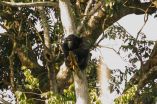Chimpanzees found to survive in degraded and human-dominated habitats
A chimpanzee population in Uganda has been found to be 3 times larger than previously estimated, according to research published in the open-access journal BMC Ecology
2015-08-25
(Press-News.org) This news release is available in German.
A chimpanzee population in Uganda has been found to be three times larger than previously estimated, according to research published in the open access journal BMC Ecology. The study suggests that chimpanzees may adapt to degraded habitats better than expected, but also highlights the importance of new and more focused conservation strategies.
The protected Budongo and Bugoma Forest Reserves together compose approximately one quarter of the estimated total chimpanzee population in Uganda. The unprotected area between these two reserves is a human-dominated landscape comprising forest with villages, agricultural lands and natural grasslands.
At least 450 km2 of forest is estimated to have been lost between the Budongo and Bugoma Forests from 2000 to 2010. As a potential corridor for chimpanzees migrating between two protected areas, these fragmented landscapes could be vital for conservation, but few studies have examined the chimpanzee population of this corridor area.
Counting chimpanzee populations also presents a number of challenges. Direct monitoring is a lengthy process, counting nests can be inaccurate, while the use of camera traps and acoustic monitoring is still in its infancy.
The researchers spent 15 months carrying out 'genetic censusing' to provide an accurate method for counting chimpanzees in the corridor region. This involved collecting 865 chimpanzee fecal samples across 633 km2 and genetically analysing them to identify the presence of 182 different chimpanzees.
They then estimated the total population size of the area to be either 256 or 319 chimpanzees, depending on the calculation used. This suggests the presence of at least nine communities containing a minimum of eight to 33 individuals each. These figures are more than three times greater than a previous estimate of around 70 chimpanzees based on small-scale nest count surveys.
Lead author Maureen McCarthy from University of Southern California, USA, said: "Our results demonstrate a much larger population than previously estimated in this region. This is very surprising given the fragmentation of forests in this region and the high human population density. Chimpanzees, therefore, appear surprisingly resilient and can survive even in degraded habitats if they are not hunted. However, their future survival remains uncertain if protection is not afforded to them and habitat loss continues unabated."
The authors say that it is highly improbable that these higher estimates are evidence of population growth since the time of the previous census. This is due to the long interval between chimpanzee births and the high rate of habitat loss throughout the region over the intervening years. The substantially higher estimates instead likely reflect the improved accuracy of the genetic censusing approach over previous estimates.
The surprising levels of chimpanzee survival in a fragmented human-dominated habitat are also likely aided by their behavioral flexibility. This includes incorporating new (often human-cultivated) foods into their diets and adopting more aggressive behaviors to mitigate human threats.
Maureen McCarthy adds: "Our study demonstrates that even unprotected and degraded habitats can have high conservation value. Though national parks and other protected areas are typically prioritized in conservation planning, unprotected areas should also be considered vital for conservation if they are highly valuable as wildlife corridors that harbor endangered species and maintain gene flow among larger populations of such species."
The authors predict that a corridor enhancement project in this region would positively impact 30% of Uganda's total chimpanzee population (including the chimpanzee populations of both Budongo and Bugoma Forests and the region between them).
INFORMATION:
Media Contact
Joel Winston
Media Officer
BioMed Central
T: +44 (0)20 3192 2081
M: +44 (0)7766540147
E: Joel.Winston@biomedcentral.com
Notes to editor:
1. Photos are available here: http://bit.ly/1E3Unbp
The credit information provided in the filenames must be included in any re-use.
2. Research article
Genetic censusing identifies an unexpectedly sizeable population of an endangered large mammal in a fragmented forest landscape
Maureen S McCarthy, Jack D Lester, Eric J Howe, Mimi Arandjelovic, Craig B Stanford and Linda Vigilant
BMC Ecology 2015
doi 10.1186/s12898-015-0052-x
After embargo, article available at journal website here: http://bmcecol.biomedcentral.com/articles/10.1186/s12898-015-0052-x
Please name the journal in any story you write. If you are writing for the web, please link to the article. All articles are available free of charge, according to BioMed Central's open access policy.
3. BMC Ecology is an open access, peer-reviewed journal that considers articles on environmental, behavioral and population ecology as well as biodiversity of plants, animals and microbes.
BMC Ecology is part of the BMC series which publishes subject-specific journals focused on the needs of individual research communities across all areas of biology and medicine. We offer an efficient, fair and friendly peer review service, and are committed to publishing all sound science, provided that there is some advance in knowledge presented by the work.
4. BioMed Central is an STM (Science, Technology and Medicine) publisher which has pioneered the open access publishing model. All peer-reviewed research articles published by BioMed Central are made immediately and freely accessible online, and are licensed to allow redistribution and reuse. BioMed Central is part of Springer Science+Business Media, a leading global publisher in the STM sector. http://www.biomedcentral.com
ELSE PRESS RELEASES FROM THIS DATE:
2015-08-25
Men whose image of themselves falls short of the traditional masculine gender norms, and who feel that others think this about them too, may be more prone to violence than men who feel comfortable in their own skin, suggests research published online in the journal Injury Prevention.
How men perceive traditional male gender norms and masculinity can affect their behaviour. In general, 'macho,' highly masculine men are more likely to engage in stereotypical male behaviours, such as risk taking, substance misuse, and acts of aggression, say the researchers.
But they wanted ...
2015-08-25
A relatively healthy diet before pregnancy is linked to a lower rate of certain heart abnormalities in babies at birth, finds research published in the Archives of Disease in Childhood (Fetal & Neonatal Edition).
Congenital heart defects are common, costly, and affect around 1% of newborns in the USA. Around one in four affected children will die infancy as a result. So far, doctors have few preventive options at their fingertips.
Some studies suggest that multivitamin supplements might lower the risk while others suggest that better diet quality might make a difference ...
2015-08-25
1. Long-term NSAID use associated with reduced colorectal cancer risk
Free abstract: http://www.annals.org/article.aspx?doi=10.7326/M15-0039
URLs go live when embargo lifts
Long-term, continuous use of low-dose aspirin and nonaspirin nonsteroidal anti-inflammatory drugs (NSAIDs) is associated with decreased colorectal cancer risk. The findings of a population-based, case-control study are published in Annals of Internal Medicine.
Colorectal cancer is the third most common non-skin cancer in the world. Colorectal neoplasms have a long progression, making colorectal ...
2015-08-24
The risk of breast cancer recurrence and mortality is decreased by endocrine therapy (ET) such as tamoxifen, but younger patients may decline it or discontinue treatment early if they are concerned about fertility, according to a study published August 24 in the JNCI: Journal of the National Cancer Institute.
To explore the reasons for lower initiation and continuation with tamoxifen treatment by younger women with breast cancer, Jacqueline S. Jeruss M.D., Ph.D. of The University of Michigan School of Medicine, Ann Arbor, MI and colleagues conducted a study of 515 premenopausal ...
2015-08-24
DALLAS, Aug. 24, 2015 -- Deaths from heart disease have declined dramatically over the last few decades but young people, particularly women, are not sharing equally in that improvement, according to new research in the American Heart Association's journal Circulation.
Using data on adults age 25 and older, researchers tracked annual percentage changes in heart disease death rates between three time periods: 1979-1989, 1990-1999 and 2000-2011. Death rates in adults 65 and over declined consistently over the decades, with accelerating improvements since 2000.
In contrast, ...
2015-08-24
ANN ARBOR, Mich. -- Concerns about fertility kept a third of young women with breast cancer from taking tamoxifen, despite its known benefit in reducing the risk of breast cancer coming back.
In addition, the study found fertility concerns led a quarter of women who started tamoxifen to stop taking it before the recommended treatment period ended.
"Our study points toward the importance of fertility to young breast cancer patients. We need to find a way to bridge the gap between this patient survivorship goal and our concerns as physicians to facilitate the best treatment ...
2015-08-24
HOUSTON - (Aug. 24, 2015) - Electronic triggers designed to search for key data, developed by researchers at Baylor College of Medicine and Michael E. DeBakey Veterans Affairs Medical Center, were able to identify and reduce follow-up delays for patients being evaluated for a diagnosis of colon or prostate cancer.
The full study can be found in the Journal of Clinical Oncology.
"Our computerized triggers scanned huge amounts of patient data in the electronic health record and flagged individuals at risk for delays in follow-up of cancer-related abnormal clinical findings," ...
2015-08-24
Danny has become a degenerate, that is, the tropical depression weakened. Satellite and Hurricane Hunter aircraft data showed that Danny degenerated into an elongated area of low pressure near the Windward Islands during the afternoon (local time) on August 24. Meanwhile two other developing low pressure areas lie to the east of Danny.
Satellite data from NOAA's GOES-East satellite at 14:45 UTC (10:45 a.m. EDT) on August 24, showed Danny had become stretched out into a trough of low pressure. At 11 a.m. EDT (1500 UTC), the remnants of Danny were located near latitude ...
2015-08-24
TALLAHASSEE, Fla. -- In the second part of his lab's recent one-two punch, Florida State University researcher Daniel Kaplan said he has solved a cell division mystery in a way that will intrigue the makers of cancer-fighting drugs.
The key, said Kaplan, a College of Medicine Department of Biomedical Sciences researcher, is a protein called Treslin.
"It can target cancer cells," he said. "Most chemotherapy also targets rapidly dividing normal cells, but this seems to have promise for not doing that. Drug companies are going to be excited."
Before cells can divide, ...
2015-08-24
SAN DIEGO, Calif. -- (Aug. 24, 2015) -- A new survey on sexual victimization issues at the University of Oregon reaffirms previous findings that there is a need to increase awareness about available services, while decreasing negative perceptions of institutional support.
Psychology professor Jennifer Freyd provided preliminary findings of the UO survey at the 20th International Summit & Training on Violence, Abuse & Trauma during a keynote session on "Campus Sexual Assault: Current Research and Prevention Approaches."
New issues also surfaced among the key findings ...
LAST 30 PRESS RELEASES:
[Press-News.org] Chimpanzees found to survive in degraded and human-dominated habitats
A chimpanzee population in Uganda has been found to be 3 times larger than previously estimated, according to research published in the open-access journal BMC Ecology



